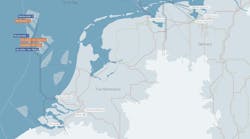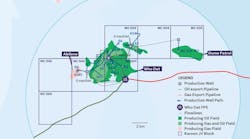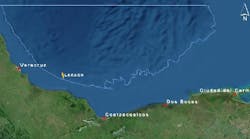Judy Maksoud, Houston
Africa
Things have been bustling lately in Nigeria. In mid-July, Afren Plc. entered a financing and technical services agreement with Excel Exploration & Production Ltd. to develop the Eremor field.
Under the agreement, Afren will be responsible for financing Phase 1 of the field development plan and will initially recover the investment from 90% of net field revenues. Following cost recovery, Afren and Excel will share production revenue and costs equally.
Eremor, an undeveloped oil field in shallow-water block OML 46, is near existing infrastructure and within 12 km (7.5 mi) of several Shell producing fields.
Phase 1 of the field development plan includes completing the existing well and constructing a 7-km (4-mi) oil evacuation line to the nearest flow station. The field development plan and environmental impact assessment have been approved.
A 3D seismic survey indicates the field contains in-place volumes of up to 30 MMbbl in the D3.0 reservoir, with a similar potential upside in the shallower D1.0 reservoir. Recoverable reserves from the D3.0 reservoir are estimated at 10 MMbbl.
Development is expected to be under way in the near term.
Total is exploring the region as well. In late July, Total’s Nigerian subsidiary Elf Petroleum Nigeria Ltd. finalized the acquisition of a 36% share in deepwater oil prospecting lease (OPL) 247, operated by Chevron.
OPL 247 lies 150 km (93 mi) offshore southeast Nigeria in water depths of 1,000-1,500 m (3,280-4,921 ft). It is near the main deep offshore operations being developed by Total.
This acquisition extends Total’s deepwater acreage offshore Nigeria, where it operates five blocks near OPL 247. The blocks include OML 130 (Akpo and Egina), OPL 221, OPL 222 (Usan), and OPL 223.
Total has gathered 3D seismic data over OPL 247 and is preparing to drill a well based on interpretation.
Total also is investing in field development. In conjunction with the Nigerian National Petroleum Corp., Total, through its subsidiary Elf Petroleum Nigeria Ltd. has launched Phase 2 of the Ofon field development project.
The Ofon field in OML 102 lies in 40 m (131 ft) water depth 50 km (31 mi) offshore. The field came onstream in Dec. 1997. Additional reserves to be developed during this phase are estimated to exceed 350 MMboe. These reserves should allow an increase of oil output by around 60,000-100,000 b/d by the end of 2010, Total says.
Scheduled Phase 2 installations include a processing platform, three drilling platforms, and an accommodation platform to house more than 120 people. The new central complex is expected to come onstream in 2010, with development drilling continuing subsequently.
Gas will be monetized through the NLNG plant, and all produced water will be re-injected into the reservoir, Total says.
The platform, to be completed by 2010, will be designed to produce 105,000 b/d of oil and 3 MMcm/d (106 MMcf/d) of gas.
Asia-Pacific
Korea’s SK Energy (formerly SK Corp.) made an interesting announcement in late July. The company claims it soon will be able to fully support South Korea’s energy independence.
“By increasing investment in our worldwide exploration and production business, we anticipate that our proven reserves will reach 700 MMbbl by 2010,” says Shin Heon-Cheol, president and CEO of SK Energy. “The amount of oil and gas we expect to obtain will surpass South Korea’s annual oil consumption. In keeping with the Korean government’s goal of attaining a national energy independence ratio of 18%, we will continue to contribute to national energy security and the nation’s energy independence.”
SK Energy is carrying out its global exploration and production activities on 25 blocks in 14 countries. The company has proven reserves of 510 MMbbl, with daily production of 24,000 bbl of oil.
The company will begin production from Brazil’s BMC-8 block in the second half of 2007. LNG production will begin in Yemen in late 2008 and Peru in late 2009.
New Zealand reached a milestone in late July, when theUmuroa FPSO began producing the Tui field in the offshore Taranaki basin.
The FPSO can process up to 50,000 b/d of oil, 118,000 b/d of water, and 120,000 barrels of total fluid per day. The vessel has oil storage capacity of 773,000 bbl and a gas compression capacity of 25 MMcf/d.
TheUmuroa is turret-moored in a water depth of 120 m (394 ft).
Australian Worldwide Exploration Ltd. operates the field with 42.5% interest. Partners are Mitsui E&P with 35% interest, New Zealand Oil & Gas with 12.5% interest, and Pan Pacific Petroleum with 10% interest.
Europe
Dana Petroleum contracted two rigs for three wells in the UK sector of the North Sea in late July. The semisubmersibleSedco 704 is preparing to spud the first well on the Kerlock prospect in the northern North Sea.
The rig will then move to drill Rinnes, close to Dana’s Melville oil discovery. The well will explore a primary objective of the main fault block, followed by a planned sidetrack into an adjacent, equally prospective block.
In the southern gas basin, theEnsco 100 jackup will drill the Scolty exploration well in the Cleeton area near the end of 2007, targeting a Rotliegend reservoir. If successful, this could lead to a joint tieback to the Cleeton platform with the Monkwell structure.
Offshore Norway, Dana is participating in two exploratory wells due to spud in August. The first will test the Jurassic Bjorn prospect, west of the Troll field, with the second well testing the Storskrymtem and underlying Grytkollen prospects.
Meanwhile, Cirrus Energy Corp. subsidiary, Cirrus Energy Nederland B.V., closed an agreement with Wintershall Noordzee B.V. to acquire its operated interest in the L8-D field, made up of 40% of the L8a license and 25% of the L8b license offshore the Netherlands.
The L8-D field was discovered by well L8-16x in 2004. The well was drillstem tested at rates up 16.1 MMcf/d (456 Mcm/d) of gas from a Rotliegend sandstone reservoir at a depth of 3,850 m (12,631 ft). The field lies in 30 m (98 ft) water depth.
Further appraisal of the discovery is required before the extent of the field can be established.
Americas
Venezuela and Cuba reportedly are joining forces to search for oil offshore Cuba. The project covers six oil blocks that lie in shallow water and deepwater areas.
The first step in the project will be a 2D seismic survey. The partnership seems to be based more on proximity and camaraderie than on technology. Neither PdVSA nor Cuba’s national oil company, CUPET, has significant experience in offshore project development.
Brazil’s Agência Nacional do Petróleo (ANP) announced in late July that the country’s ninth bid round would take place Nov. 27-28, 2007, in Rio de Janeiro.
The blocks on offer cover approximately 98,000 sq km (37,838 sq mi) in the Campos, Santos, Espírito Santo, Pará-Maranhão, Parnaíba, Pernambuco-Paraíba, Potiguar, Recôncavo, and Rio do Peixe basins.
ANP says the ninth round will follow the model adopted previously. There are 153 “high potential offshore sites” in the Campos, Espírito Santo, and Santos basins, which are areas of interest for big and medium investors.
Also on offer are 69 blocks in new offshore areas referred to as “offshore frontier sites.” The objective in those areas, ANP says, is to draw attention to new areas.
While newcomers soon will have the chance to get into the game offshore Brazil, Devon has reached a milestone with first oil production from the Polvo field. Devon is the first operator to bring a field into production without Petrobras involvement.
Production is via a fixed drilling and production platform connected to an FPSO. The first shipment from the FPSO is expected in October.
Polvo lies in 300 ft (91 m) water depth in block BM-C-8 in the Campos basin. Devon expects production to reach 50,000 b/d of oil by the end of 2008. Devon operates the BM-C-8 block with 60% interest. SK Corp. of Korea holds the remainder.
Mediterranean
Candax Energy Inc. began drilling the first well in a three-well development program on the El Bibane oil and gas field offshore Tunisia in August.
TheWest Titania jackup drilled the EBB-4 well and was to move to the second well location, EBB-3RE2, to re-complete the existing well by drilling a new, horizontal production well in the oil column. The final well, EBB-5, will be used as a gas re-injection well. First gas injection likely will begin early in December.
First oil and gas production from EBB-4 is expected by the first week of Oct. 2007.
Middle East
In late July, Abu Dhabi Marine Operating Co. awarded Technip and the National Petroleum Construction Co. a $370-million EPC contract for the Zakum gas processing facilities.
The project calls for a new gas compression platform with two gas turbine-driven centrifugal compression trains, a triethylene glycol dehydration unit, an air cooler, and a vapor recovery system to connect to the existing lower Zakum platform.
Technip will provide the engineering and project management while NPCC carries out fabrication and offshore installation. Purchasing will be done jointly.
The facility is scheduled to be in operation Jan. 2010.
Central Asia
In early August, the Kazakh and Azerbaijani state oil companies signed a memorandum on the joint implementation of a Trans-Caspian project.
The project would include oil terminals on Kazakhstan’s Caspian shore, tankers, oil-loading terminals in Azerbaijan, and facilities linking these terminals to the Baku-Tbilisi-Ceyhan pipeline.
KazMunaiGaz and Socar say they also have signed an oil and gas cooperation agreement that involves the joint use of Socar’s oil and gas infrastructure.
Woodside moves ahead with Pluto
In early August, Woodside Petroleum Ltd.’s board approved development of the Pluto LNG project, which will be based on gas supply from the company’s Pluto and Xena gas fields in permit WA-350-P offshore Western Australia. According to Woodside, this project represents the largest single investment by one company in Australia’s resources sector.
The decision to proceed with the Pluto project represents the most significant step in Western Australia’s gas industry since the initial development of the Woodside-operated North West Shelf in the 1980s, the company says.
Pluto will more than triple the company’s current LNG equity production, Woodside says. Pluto Train 1 is the first step. Beyond that, the company believes there is the potential for significant upside value to be created from future expansion.
Pluto is surrounded by gas fields, the majority of which are yet to be developed. Woodside has significant exploration acreage to the north and northwest of Pluto.
If gas is discovered at nearby Ixion (0.5-1 tcf) and/or Belicoso (1-1.5 tcf), a tie-back to Pluto is possible and could open other adjacent opportunities.
The centerpiece of the Pluto gas project will be the development of the Burrup LNG Park, just south of the existing North West Shelf Venture on the Burrup Peninsula.
Woodside’s board also has given approval to begin studies on expanding LNG capacity by adding a second and third train and a domestic gas facility to supply the Western Australia market. The size of subsequent LNG trains and the technology to be used will be evaluated during the study.
The field is expected to go online in 2010.







